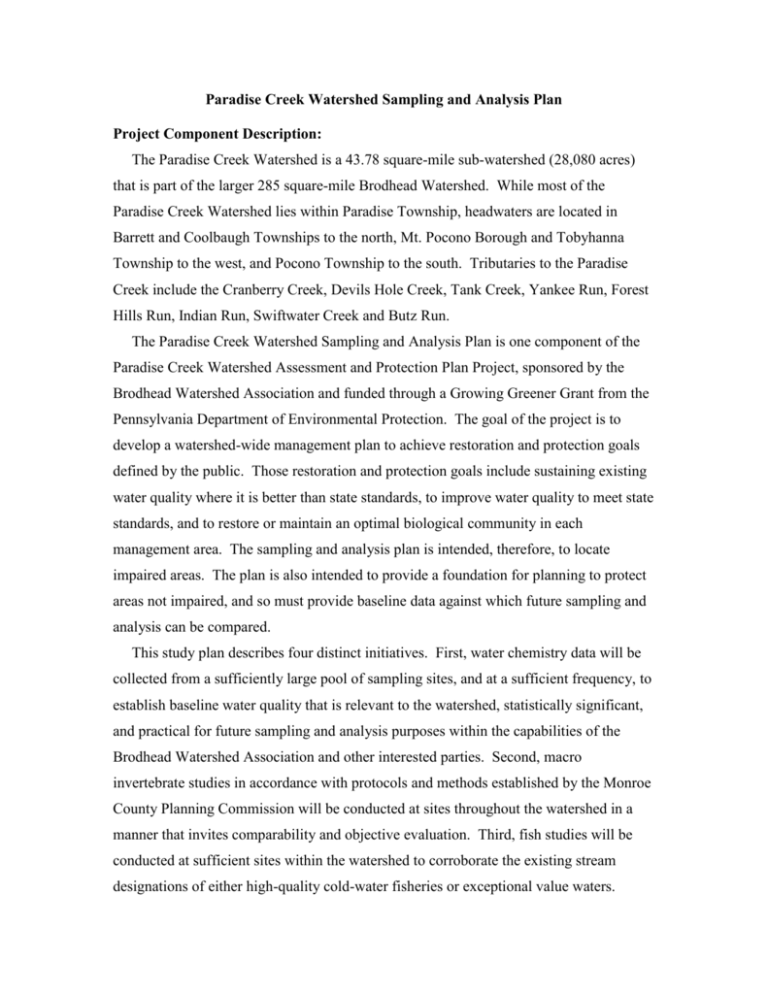Paradise Creek Watershed Sampling and Analysis Plan
advertisement

Paradise Creek Watershed Sampling and Analysis Plan Project Component Description: The Paradise Creek Watershed is a 43.78 square-mile sub-watershed (28,080 acres) that is part of the larger 285 square-mile Brodhead Watershed. While most of the Paradise Creek Watershed lies within Paradise Township, headwaters are located in Barrett and Coolbaugh Townships to the north, Mt. Pocono Borough and Tobyhanna Township to the west, and Pocono Township to the south. Tributaries to the Paradise Creek include the Cranberry Creek, Devils Hole Creek, Tank Creek, Yankee Run, Forest Hills Run, Indian Run, Swiftwater Creek and Butz Run. The Paradise Creek Watershed Sampling and Analysis Plan is one component of the Paradise Creek Watershed Assessment and Protection Plan Project, sponsored by the Brodhead Watershed Association and funded through a Growing Greener Grant from the Pennsylvania Department of Environmental Protection. The goal of the project is to develop a watershed-wide management plan to achieve restoration and protection goals defined by the public. Those restoration and protection goals include sustaining existing water quality where it is better than state standards, to improve water quality to meet state standards, and to restore or maintain an optimal biological community in each management area. The sampling and analysis plan is intended, therefore, to locate impaired areas. The plan is also intended to provide a foundation for planning to protect areas not impaired, and so must provide baseline data against which future sampling and analysis can be compared. This study plan describes four distinct initiatives. First, water chemistry data will be collected from a sufficiently large pool of sampling sites, and at a sufficient frequency, to establish baseline water quality that is relevant to the watershed, statistically significant, and practical for future sampling and analysis purposes within the capabilities of the Brodhead Watershed Association and other interested parties. Second, macro invertebrate studies in accordance with protocols and methods established by the Monroe County Planning Commission will be conducted at sites throughout the watershed in a manner that invites comparability and objective evaluation. Third, fish studies will be conducted at sufficient sites within the watershed to corroborate the existing stream designations of either high-quality cold-water fisheries or exceptional value waters. 2 Finally, a quality assurance/quality control program will be followed to ensure the data from this study maintains scientific integrity, and provides guidance for future monitoring. The results of this study will be published in both written and electronic form, and presented on the website being designed for the project. The published material will also contain all QA/QC data and any deviations from that program. The data will be presented as raw data, but with adequate explanatory text for the lay public to interpret the results. Sampling and Analysis Plan Staff Project Manager Debra Brady will coordinate implementation of this plan. Thomas Brady will conduct all water chemistry sampling and field analysis, with assistance from local students and interested members of the public. Mr. Brady will be responsible for adherence to the QA/QC program in the field, and for collecting all necessary data on field data sheets and chain of custody forms provided herein. Water chemistry analysis will be performed by Pocono Environmental Laboratories in compliance with the quality assurance and quality control methods required by the United States Environmental Protection Agency for certified drinking water laboratories. Pocono Environmental Laboratory will also provide calibration and maintenance of field equipment as required by the manufacturer. Macro invertebrate studies will be conducted by either the Monroe County Planning Commission with assistance from the Monroe County Conservation District, Aquatic Resource Consulting (ARC), or EA Engineering through the Mt. Pocono Municipal Authority. East Stroudsburg University (ESU) students majoring in biology may assist in sample collections under the supervision of either Aquatic Resource Consulting or Carl Meyer of MCCD, with the signed recommendation of Jeri JewettSmith, Ph.D., Director of Environmental Studies at ESU. Only Aquatic Resource Consulting, Carl Meyer or EA Engineering will evaluate sub-samples. The macro invertebrate studies will include habitat evaluations as developed by MCPC. Fish studies will be conducted by Aquatic Resource Consulting with assistance from students and interested members of the public. 3 Sampling Sites and Rationale: On January 15, 2003 members of the Project Team met at the offices of BortonLawson Engineering to determine suitable management areas within the watershed. Present were Paul DeBarry and Eric Yang of Borton-Lawson Engineering, Greg Cavallo and Bob Limbeck of the Delaware River Basin Commission, Jim Sheehan of East Stroudsburg University, Eric Bartolacci of the Monroe County Planning Commission, Craig Todd of the Monroe County Conservation District and Project Manager Debra Brady. Using Geographical Information System (GIS) software, the group evaluated datasets including eco regions, physiographic regions, geology, soils, topography, land uses, zoning, political boundaries, sub-basins developed for Act 167 regulations in the area, and anecdotal information regarding the locations of significant water withdrawals and potential sources of contamination. At the conclusion of that meeting, sub-basins were merged using GIS to describe the following management areas: 4 Cranberry Creek (CC), which includes drainage areas that lead to the Cranberry Creek from upstream of the stream’s confluence with the Paradise Creek main stem near Brown’s Hill Road to headwaters located in Barrett Township (refer to Figure 1). 5 Devils Hole Creek (DH), which includes drainage areas that lead to the Devils Hole Creek from the stream’s confluence with the Paradise Creek main stem to headwaters located in Coolbaugh Township (refer to Figure 2). 6 Tank Creek/Yankee Run (TY), which includes drainage areas that lead to both Tank Creek and Yankee Run from below the two streams’ confluence to headwaters located in Coolbaugh Township and Mt. Pocono Borough (refer to Figure 3). 7 Forest Hills Run (FH), which includes drainage areas that lead to the Forest Hills Run from the confluence with Swiftwater Creek to headwaters located in Mt. Pocono Borough (refer to figure 4). 8 Upper Swiftwater Creek (US), which includes drainage areas that lead to the Swiftwater Creek from Rt. 611 in Pocono Township to headwaters located in Tobyhanna Township (refer to figure 5). 9 Lower Swiftwater Creek (LS), which includes drainage areas that lead to Swiftwater Creek from the confluence with the Paradise Creek main stem to Rt. 611 in Pocono Township (refer to figure 6). 10 Upper Paradise main stem (UP), which includes drainage areas that lead to the Paradise Creek from upstream of the confluence with the Swiftwater Creek to the base of the Tank Creek/Yankee Run management area (refer to figure 7). 11 Lower Paradise mainstem (LP), which includes drainage areas that lead to the Paradise Creek from the confluence of the Paradise and Brodhead Creeks to the base of the Upper Paradise management area (refer to figure 8). 12 Butz Run (BR), which includes drainage areas that lead to the Butz Run from the confluence with the Paradise mainstem to headwaters located in Pocono Township (refer to figure 9). 13 The base of these nine management areas, and the inclusion of that portion of the Swiftwater Creek upstream of the confluence with the Forest Hills Run, provides ten sampling sites of particular significance to the watershed. These ten sampling sites will be monumented and described using Geographical Positioning System (GPS) as fixed sampling sites for this study and for future studies. Flow velocity and level will be measured at each site during each sampling event. Cross-sectional areas will be measured during the spring and rating curves will be developed to associate volume flow with each sampling event. Additional sampling sites based on information similar to that reviewed at the January 15, 2003 morning meeting were determined later that day at a separate meeting held at the Monroe County Conservation District. Present were Ed Molesky of Aqua-Link, Bob Limbeck of the Delaware River Basin Commission, Project Technician Tom Brady, Carl Meyer, Darryl Speicher and Craig Todd of the Monroe County Conservation District, Brian Oram of Wilkes University, Don Baylor of Aquatic Resource Consulting, Edie Stevens of Brodhead Watershed Association, Sherry Wills of Pennsylvania Department of Environmental Protection, Eric Bartolacci of the Monroe County Planning Commission, and Project Manager Debra Brady. Additional sampling sites will include: 1. Cranberry Creek where the stream crosses Cranberry Creek Road. 2. Cranberry Creek headwaters in Barrett Township. 3. Devils Hole Creek below Pocono Farms East in Coolbaugh Township. 4. Devils Hole Creek at the State Game Lands boundary. 5. Tank Creek, downstream of Devils Hole Road. 6. Yankee Run, upstream of Devils Hole Road. 7. Forest Hills Run downstream of Carlton Road. 8. Forest Hills Run upstream of the Mt. Airy Lodge parking lot. 9. Forest Hills Run above the Mt. Pocono Municipal STP. 10. Indian Run upstream of Fairview Avenue. 11. Paradise Creek upstream of Red Rock Road. 14 12. Paradise Creek upstream of confluence with Cranberry Creek. 13. Swiftwater Creek near Lake Road. 14. Swiftwater Creek upstream of Manor Drive. 15. Butz Run at Clubhouse Road. 16. Butz Run at Rt. 715 (upstream of northern crossing). 17. Butz Run at Rt. 715 (upstream of southern crossing). 18. Swiftwater Creek 200 yards downstream of Aventis Pasteur. Refer to Table 1 (sites.xls) for sample sites, site names that concur with the system already developed by the Monroe County Planning Commission, and latitude and longitude descriptions. A separate sampling and analysis plan will be used during storm events to evaluate nonpoint source impacts at the management area base points only, and/or upstream and downstream of suspected sources of contamination, as resources allow. All sampling sites will be named in a manner consistent with procedures established by the Monroe County Planning Commission. Data will be collected and recorded at each sampling site during each sampling event regarding ambient temperature, weather conditions, and most recent precipitation event. A habitat analysis will be conducted at each sampling site, consistent with procedures developed by the Monroe County Planning Commission, at the time macro invertebrate studies are conducted. Sampling Frequency and Parameters: Water chemistry analysis will be conducted at all sites monthly for one year. Field analysis will include flow, temperature, pH, conductivity, and dissolved oxygen. A multi-parameter sensor capable of logging sample results at 15 minute intervals will be used at management area base points for 24-hour intervals each month to develop a sufficient number of data points to verify statistical significance. Grab samples will be taken and analyzed monthly for one year at the management area base points. Laboratory analysis will include pH, nitrite, nitrate, total phosphorus, total suspended solids, and fecal coliform. On one occasion at each management base point, laboratory analysis will include alkalinity, total hardness, and metals. On one occasion at each management base point, sediment samples will be taken and analyzed for PCBs and metals. 15 Macro invertebrate studies will be performed once at each sampling site during the summer season. Macro invertebrate sampling and analysis protocols are described in the Monroe County Water Quality Study dated 2001. Fish studies will be conducted at selected sites on tributaries at the discretion of Aquatic Resource Consulting. Stormwater sampling and analysis will be conducted at selected management area base points during a minimum of five storm events using composite samplers and grab samples, and both field and laboratory analysis. Parameters will include water level, temperature, pH, conductivity, total suspended solids, total dissolved solids, fecal coliform (discrete sample), nitrite, nitrate, total phosphorus, and oil & grease (discrete sample). As time and resources allow, additional storm event sampling and analysis may be conducted above and below any suspected sources of contamination. Sample Collection and Holding: Grab samples for laboratory analysis will be collected in appropriate containers prepared by the laboratory as described in Table 2. All grab samples will be stored in coolers and delivered to the laboratory on the same day they are collected by field personnel. Composite samples will be collected using a Global Water Stormwater Sampler (Model SS201). This sampler allows for collection of both first flush and composite samples to be collected over time during a storm event. Field analysis will be conducted using a YSI 600XLM sonde, and a YSI 650 MDS data logger. Flow velocity will be measured using a Global Water FP201 flow probe. Methods and Detection Limits: Field data will be collected using a YSI multi-parameter deployable monitor. Maintenance and calibration of this unit will be conducted by field personnel with assistance, as needed, by Pocono Environmental Laboratories. Initial calibration of the unit, and maintenance and calibration training for field personnel was conducted at the Environmental Science Laboratory at Wilkes University by Brian Oram and John Pagoda, with assistance from Jeremy Young of Pocono Environmental Laboratories on March 25, 2003. The field sensors will be calibrated at the beginning and end of each day of use with appropriate standards, or more frequently as recommended by the 16 manufacturer. Field data collected using the YSI unit will include flow, temperature, pH, conductivity, and dissolved oxygen. Data will be uploaded to a YSI data logger, and then transferred to a spreadsheet using EcoWatch software provided by the manufacturer. The sensor specifications from the manufacturer include the following: Temperature Sensor Type Range Accuracy Resolution Depth Thermistor -5 to 45 ◦C +/- 0.15 ◦C 0.01 ◦ C 200 meters Dissolved Oxygen, % saturation Sensor Type Rapid Pulse – Clark type, polarographic Range 0 to 500% air saturation Accuracy 0 to 200% air saturation, +/- 2% of the reading or 2% air saturation, whichever is greater 200 to 500% air saturation, +/- 6% of the reading Resolution 0.1% air saturation Depth 200 meters Dissolved Oxygen, mg/l Sensor Type Rapid Pulse – Clarke type, polarographic Range 0 to 50 mg/l Accuracy 0 to 20 mg/l, +/- 2% of the reading or 0.2 mg/l, whichever is greater 20 to 50 mg/l, +/- 6% of the reading Resolution 0.01 mg/l Depth 200 meters pH Sensor Type Range Accuracy Resolution Depth Glass combination electrode 0 to 14 units +/- 0.2 units 0.01 units 200 meters ORP Sensor Type Range Accuracy Resolution Depth Platinum button -999 to +999 mV +/- 20 mV 0.1 mV 200 meters 17 Conductivity Sensor Type Range Accuracy Resolution Depth 4 electrode cell with autoranging 0 to 100 mS/cm +/- 0.5% of reading + 0.001 mS/cm 0.001 mS/cm to 0.1 mS/cm (range dependent) 200 meters Table 2: Parameter Baseline Monitoring Water Level Water Flow Temperature pH Conductivity Dissolved oxygen Total Dissolved solids pH Nitrite Nitrate Total Phosphorus Total suspended solids Fecal Coliform Alkalinity Total Hardness Aluminum Antimony Arsenic Barium Beryllium Cadmium Calcium Chromium Cobalt Copper Iron Lead Mercury Magnesium Manganese Nickel Selenium Silver Thallium Vanadium Zinc Potassium Sodium Method MDL Holding Sample Bottle Pres. Staff Guage Field Sensor Field Sensor Field Sensor Field Sensor Field Sensor Field Sensor EPA 150.1 SM 4500 NO2B SM 4500 NO3D EPA 365.2 EPA 160.2 SM 9222B SM 2320B EPA 130.2 EPA 202.1 EPA 204.1 EPA 206.2 EPA 208.1 EPA 210.1 EPA 213.1 EPA 215.1 EPA 218.1 EPA 219.1 EPA 220.1 EPA 236.1 EPA 239.1 EPA 245.1 EPA 242.1 EPA 243.1 EPA 249.1 EPA 270.1 EPA 272.1 EPA 279.1 EPA 286.1 EPA 289.1 EPA 258.1 EPA 273.1 asa* asa* asa* asa* asa* asa* asa* n/a 0.005 mg/l 0.1 mg/l 0.02 mg/l 1.0 mg/l 1 CFU/100 ml 1.0 mg/l 1.0 mg/l 0.1 mg/l 0.1 mg/l 0.005 mg/l 0.1 mg/l 0.02 mg/l 0.02 mg/l 0.02 mg/l 0.02 mg/l 0.05 mg/l 0.02 mg/l 0.03 mg/l 0.10 mg/l 0.0005 mg/l 0.02 mg/l 0.04 mg/l 0.05 mg/l 0.005 mg/l 0.02 mg/l 0.1 mg/l 2.0 mg/l 0.02 mg/l 0.02 mg/l 0.02 mg/l n/a n/a n/a n/a n/a n/a n/a ASAP 48 hours 48 hours 28 days 7 days 6 hours 7 days 28 days 6 months 6 months 6 months 6 months 6 months 6 months 6 months 6 months 6 months 6 months 6 months 6 months 28 days 6 months 6 months 6 months 6 months 6 months 6 months 6 months 6 months 6 months 6 months Field Field Field Field Field Field Field Grab Grab Grab Grab Grab Grab Grab Grab Grab Grab Grab Grab Grab Grab Grab Grab Grab Grab Grab Grab Grab Grab Grab Grab Grab Grab Grab Grab Grab Grab Grab n/a n/a n/a n/a n/a n/a n/a 1-L-P 1-L-P 1-L-P 1-L-P 1-L-P 1-120-P 1-L-P 1-L-P 1-L-P 1-L-P 1-L-P 1-L-P 1-L-P 1-L-P 1-L-P 1-L-P 1-L-P 1-L-P 1-L-P 1-L-P 1-L-P 1-L-P 1-L-P 1-L-P 1-L-P 1-L-P 1-L-P 1-L-P 1-L-P 1-L-P 1-L-P n/a n/a n/a n/a n/a n/a n/a n/a n/a n/a H2SO4 n/a Na2S2O3 n/a n/a HNO3 HNO3 HNO3 HNO3 HNO3 HNO3 HNO3 HNO3 HNO3 HNO3 HNO3 HNO3 HNO3 HNO3 HNO3 HNO3 HNO3 HNO3 HNO3 HNO3 HNO3 HNO3 HNO3 18 Table 2 (continued) Parameter Storm Events Water Level Water Flow Temperature pH Conductivity Dissolved Oxygen pH Nitrite Nitrate Total Phosphorus Total Suspended Solids Fecal Coliform Oil & Grease Lake Samples Temperature pH Conductivity Dissolved Oxygen Specific Conductance Alkalinity Total Suspended Solids Total Phosphorus Chlorophyll -a Hardness Dissolved Reactive Phosphorus Ammonia Nitrogen Nitrate Nitrogen Nitrite Nitrogen Total Kjeldahl Nitrogen Sediment Samples PCBs Aluminum Cadmium Copper Iron Lead Manganese Mercury Zinc Total Phosphorus Total Organic Carbon Grain size and distribution Disgestion for sed. Samples *asa = as specified above *tbd = to be determined Method MDL Holding Sample Bottle Pres. Staff guage Field sensor Field sensor Field sensor Field sensor Field sensor EPA 150.1 SM 4500 NO2B SM 4500 NO3D EPA 365.2 EPA 160.2 SM 9222B EPA 1664 asa asa asa asa asa asa n/a 0.005 mg/l 0.1 mg/l 0.02 mg/l 1.0 mg/l 1 CFU/100 ml 1.6 mg/l n/a n/a n/a n/a n/a n/a ASAP 48 hours 48 hours 28 days 7 days 6 hours 28 days Field Field Field Field Field Field Composite Composite Composite Composite Composite Grab Grab n/a n/a n/a n/a n/a n/a 1-L-P 1-L-P 1-L-P 1-L-P 1-L-P 1-120-P 1-L-G n/a n/a n/a n/a n/a n/a n/a n/a n/a H2SO4 n/a Na2S2O3 H2SO4 Field sensor Field sensor Field sensor Field sensor Field sensor SM 2320B EPA 160.2 EPA 365.2 tbd* EPA 130.2 EPA 365.3 SM 4500 NH3E SM 4500 NO3D SM 4500 NO2B SM 4500-NorgB asa asa asa asa asa 1.0 mg/l 1.0 mg/l 0.02 mg/l tbd* 1.0 mg/l 0.02 mg/l 0.1 mg/l 0.1 mg/l 0.005 mg/l 0.3 mg/l n/a n/a n/a n/a n/a 7 days 7 days 28 days tbd* 28 days 28 days 28 days 48 hours 48 hours 28 days Field Field Field Field Field Grab Grab Grab Grab Grab Grab Grab Grab Grab Grab n/a n/a n/a n/a n/a 1-L-P 1-L-P 1-L-P tbd* 1-L-P 1-L-P 1-L-P 1-L-P 1-L-P 1-L-P n/a n/a n/a n/a n/a n/a n/a H2SO4 tbd* n/a n/a H2SO4 n/a n/a H2SO4 SW-846(8020) SW-846(6010) SW-846(6010) SW-846(6010) SW-846(6010) SW-846(6010) SW-846(6010) SW-846(7471A) SW-846(6010) EPA 365.1 EPA 415.1 ASTM D-422 various 0.5 mg/kg 3.31 mg/kg 0.091 mg/kg 0.16 mg/kg 4.77 mg/kg 0.94 mg/kg 0.07 mg/kg 0.0105 mg/kg 0.36 mg/kg 10 mg/kg 60 mg/kg 1 or 75 um n/a 7 days 28 days 28 days 28 days 28 days 28 days 28 days 28 days 28 days 28 days 28 days n/a n/a Grab Grab Grab Grab Grab Grab Grab Grab Grab Grab Grab Grab n/a 4oz-G 4oz-G 4oz-G 4oz-G 4oz-G 4oz-G 4oz-G 4oz-G 4oz-G 4oz-G 4oz-G 4oz-G n/a n/a n/a n/a n/a n/a n/a n/a n/a n/a n/a n/a n/a n/a 19 Quality Assurance and Quality Control Field blanks will be collected once for every ten samples collected. Field blanks will be analyzed at Pocono Environmental Laboratories. Duplicate samples will be collected once for every 5 percent of samples taken. Split samples will be collected once for every 20 samples collected. Split samples will be analyzed at Analytical Services, Inc. Method blanks will be analyzed for every 10 percent of samples that enter the laboratory. These blanks will be prepared, analyzed, and recorded by Pocono Environmental Laboratories. Chain of custody forms will be completed for each sample delivered to each laboratory. Field data sheets will be completed for each site during each sampling event. Cooler temperature will be maintained within a range of one and four degrees centigrade using ice, and cooler temperature will be recorded on the field data sheet at the time samples are delivered to the laboratory. Internal laboratory QA/QC protocols are attached as Appendix A. Composite sampler containers will be decontaminated following each sample event using tap water and an anionic cleaner such as Alconox. Equipment will then be triple rinsed with deionized water. Field sensors will be rinsed using deionized water and stored in accordance with manufacturer’s instructions. Data Review and Analysis: Field data will be uploaded from a data logger directly into a spreadsheet using EcoWatch software. Laboratory data will be downloaded directly into a spreadsheet designed by Brian Oram of Wilkes University. Data that does not meet QA/AC criteria described in this plan will be flagged, and discrepancies will be described. Paper copies of laboratory analysis results and all field data sheets will be maintained by the Project Manager and will be available for review. Data indicating conditions that do not meet stream designation standards in Chapter 93 of the Pennsylvania Code will be forwarded to the Pennsylvania Department of Environmental Protection for investigation. The Paradise Creek Watershed Assessment and Protection Plan Project Technical team will interpret the data to categorize general stream health and identify areas that warrant additional investigation or remediation. All findings will be presented to the public.


![Grab bag demonstration []](http://s2.studylib.net/store/data/005719196_1-962c61dce439ca2ab13ba76af5c7e06c-300x300.png)



